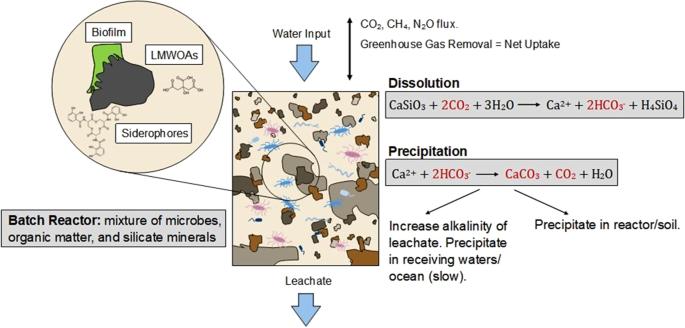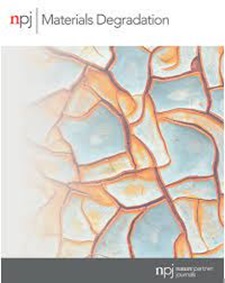有机碳源控制微生物橄榄石在小型流动生物反应器中的溶解,以去除二氧化碳
IF 6.6
2区 材料科学
Q1 MATERIALS SCIENCE, MULTIDISCIPLINARY
引用次数: 0
摘要
二氧化碳去除方法的开发以及二氧化碳排放量的减少,对于实现《巴黎协定》中提出的将全球升温控制在 1.5 °C以内的目标至关重要。在此,我们正在研究有机碳原料对支持小规模流经生物反应器的硅酸盐矿物风化及随后的二氧化碳封存的重要性。在这里,我们将两种细菌和两种真菌结合在一起,它们的风化潜力已被广泛报道,在简单的流经生物反应器(柱)中,这些生物反应器(柱)由绿泥石和广泛存在的廉价有机碳源(小麦秸秆、猪粪和生物垃圾的生物废弃物沼渣以及粪便堆肥)组成,历时六周。与相应的非生物对照组相比,接种的秸秆和沼渣柱释放出更多的总碱度(约为对照组的 2 倍),并产生更多的溶解和固体无机碳(秸秆为 29%,沼渣为 13%),这表明由于生物增强了硅酸盐的风化作用,二氧化碳的固碳量有所增加。与沼渣和粪便堆肥柱相比,秸秆柱中的微生物生物量更高,磷脂脂肪酸衍生的微生物总生物量是其他生物柱的 10 倍。扫描电子显微镜成像显示,秸秆柱中矿物表面的定殖和生物膜形成最为广泛。生物秸秆柱和沼渣柱的固碳量分别比非生物柱多 50 毫克和 14 毫克,而粪便柱则没有差别。选择有机碳源来支持流经生物反应器中的微生物群落,可控制硅酸盐风化率和二氧化碳固存。本文章由计算机程序翻译,如有差异,请以英文原文为准。

Organic carbon source controlled microbial olivine dissolution in small-scale flow-through bioreactors, for CO2 removal
The development of carbon dioxide removal methods, coupled with decreased CO2 emissions, is fundamental to achieving the targets outlined in the Paris Agreement limiting global warming to 1.5 °C. Here we are investigating the importance of the organic carbon feedstock to support silicate mineral weathering in small-scale flow through bioreactors and subsequent CO2 sequestration. Here, we combine two bacteria and two fungi, widely reported for their weathering potential, in simple flow through bioreactors (columns) consisting of forsterite and widely available, cheap organic carbon sources (wheat straw, bio-waste digestate of pig manure and biowaste, and manure compost), over six weeks. Compared to their corresponding abiotic controls, the inoculated straw and digestate columns release more total alkalinity (~2 times more) and produce greater dissolved and solid inorganic carbon (29% for straw and 13% for digestate), suggesting an increase in CO2 sequestration because of bio-enhanced silicate weathering. Microbial biomass is higher in the straw columns compared to the digestate and manure compost columns, with a phospholipid fatty acid derived total microbial biomass 10 x greater than the other biotic columns. Scanning Electron Microscopy imaging shows the most extensive colonisation and biofilm formation on the mineral surfaces in the straw columns. The biotic straw and digestate columns sequester 50 and 14 mg C more than their abiotic controls respectively, while there is no difference in the manure columns. The selection of organic carbon sources to support microbial communities in the flow through bioreactors controlls the silicate weathering rates and CO2 sequestration.
求助全文
通过发布文献求助,成功后即可免费获取论文全文。
去求助
来源期刊

npj Materials Degradation
MATERIALS SCIENCE, MULTIDISCIPLINARY-
CiteScore
7.80
自引率
7.80%
发文量
86
审稿时长
6 weeks
期刊介绍:
npj Materials Degradation considers basic and applied research that explores all aspects of the degradation of metallic and non-metallic materials. The journal broadly defines ‘materials degradation’ as a reduction in the ability of a material to perform its task in-service as a result of environmental exposure.
The journal covers a broad range of topics including but not limited to:
-Degradation of metals, glasses, minerals, polymers, ceramics, cements and composites in natural and engineered environments, as a result of various stimuli
-Computational and experimental studies of degradation mechanisms and kinetics
-Characterization of degradation by traditional and emerging techniques
-New approaches and technologies for enhancing resistance to degradation
-Inspection and monitoring techniques for materials in-service, such as sensing technologies
 求助内容:
求助内容: 应助结果提醒方式:
应助结果提醒方式:


